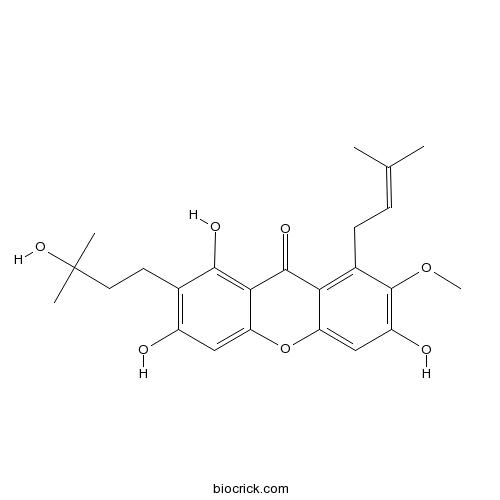CratoxyloneCAS# 149155-01-1 |

Quality Control & MSDS
3D structure
Package In Stock
Number of papers citing our products

| Cas No. | 149155-01-1 | SDF | Download SDF |
| PubChem ID | 102004659 | Appearance | Yellow powder |
| Formula | C24H28O7 | M.Wt | 428.5 |
| Type of Compound | Xanthones | Storage | Desiccate at -20°C |
| Solubility | Soluble in Chloroform,Dichloromethane,Ethyl Acetate,DMSO,Acetone,etc. | ||
| Chemical Name | 1,3,6-trihydroxy-2-(3-hydroxy-3-methylbutyl)-7-methoxy-8-(3-methylbut-2-enyl)xanthen-9-one | ||
| SMILES | CC(=CCC1=C2C(=CC(=C1OC)O)OC3=CC(=C(C(=C3C2=O)O)CCC(C)(C)O)O)C | ||
| Standard InChIKey | JSXIWUDODLMCGG-UHFFFAOYSA-N | ||
| Standard InChI | InChI=1S/C24H28O7/c1-12(2)6-7-14-19-17(11-16(26)23(14)30-5)31-18-10-15(25)13(8-9-24(3,4)29)21(27)20(18)22(19)28/h6,10-11,25-27,29H,7-9H2,1-5H3 | ||
| General tips | For obtaining a higher solubility , please warm the tube at 37 ℃ and shake it in the ultrasonic bath for a while.Stock solution can be stored below -20℃ for several months. We recommend that you prepare and use the solution on the same day. However, if the test schedule requires, the stock solutions can be prepared in advance, and the stock solution must be sealed and stored below -20℃. In general, the stock solution can be kept for several months. Before use, we recommend that you leave the vial at room temperature for at least an hour before opening it. |
||
| About Packaging | 1. The packaging of the product may be reversed during transportation, cause the high purity compounds to adhere to the neck or cap of the vial.Take the vail out of its packaging and shake gently until the compounds fall to the bottom of the vial. 2. For liquid products, please centrifuge at 500xg to gather the liquid to the bottom of the vial. 3. Try to avoid loss or contamination during the experiment. |
||
| Shipping Condition | Packaging according to customer requirements(5mg, 10mg, 20mg and more). Ship via FedEx, DHL, UPS, EMS or other couriers with RT, or blue ice upon request. | ||
| Description | 1. Cratoxylone exhibits potent activity in vitro against Plasmodium falciparum chloroquine-resistant strain W2, with the IC₅₀ value belows 3 uM. |
| Targets | Antifection |

Cratoxylone Dilution Calculator

Cratoxylone Molarity Calculator
| 1 mg | 5 mg | 10 mg | 20 mg | 25 mg | |
| 1 mM | 2.3337 mL | 11.6686 mL | 23.3372 mL | 46.6744 mL | 58.3431 mL |
| 5 mM | 0.4667 mL | 2.3337 mL | 4.6674 mL | 9.3349 mL | 11.6686 mL |
| 10 mM | 0.2334 mL | 1.1669 mL | 2.3337 mL | 4.6674 mL | 5.8343 mL |
| 50 mM | 0.0467 mL | 0.2334 mL | 0.4667 mL | 0.9335 mL | 1.1669 mL |
| 100 mM | 0.0233 mL | 0.1167 mL | 0.2334 mL | 0.4667 mL | 0.5834 mL |
| * Note: If you are in the process of experiment, it's necessary to make the dilution ratios of the samples. The dilution data above is only for reference. Normally, it's can get a better solubility within lower of Concentrations. | |||||

Calcutta University

University of Minnesota

University of Maryland School of Medicine

University of Illinois at Chicago

The Ohio State University

University of Zurich

Harvard University

Colorado State University

Auburn University

Yale University

Worcester Polytechnic Institute

Washington State University

Stanford University

University of Leipzig

Universidade da Beira Interior

The Institute of Cancer Research

Heidelberg University

University of Amsterdam

University of Auckland

TsingHua University

The University of Michigan

Miami University

DRURY University

Jilin University

Fudan University

Wuhan University

Sun Yat-sen University

Universite de Paris

Deemed University

Auckland University

The University of Tokyo

Korea University
- Brugine
Catalog No.:BCN1899
CAS No.:14912-30-2
- AG 825
Catalog No.:BCC7113
CAS No.:149092-50-2
- Brusatol
Catalog No.:BCN8278
CAS No.:14907-98-3
- H-D-Trp-OMe.HCl
Catalog No.:BCC3118
CAS No.:14907-27-8
- (S)-WAY 100135 dihydrochloride
Catalog No.:BCC6993
CAS No.:149007-54-5
- Dexrazoxane HCl (ICRF-187, ADR-529)
Catalog No.:BCC1087
CAS No.:149003-01-0
- D-Isomenthol
Catalog No.:BCN8540
CAS No.:23283-97-8
- Gallic acid
Catalog No.:BCN1668
CAS No.:149-91-7
- Scopolamine butylbromide
Catalog No.:BCN5006
CAS No.:149-64-4
- Erythritol
Catalog No.:BCN1664
CAS No.:149-32-6
- Fmoc-Inp-OH
Catalog No.:BCC3266
CAS No.:148928-15-8
- 3-[2-Cyclopropyl-4-(4-fluorophenyl)-3-quinolinyl-2-propenal
Catalog No.:BCC8600
CAS No.:148901-68-2
- Homaloside D
Catalog No.:BCN1661
CAS No.:149155-19-1
- Eriodictyol chalcone
Catalog No.:BCN8276
CAS No.:14917-41-0
- 3-(2,4-Dihydroxybenzyl)-5-hydroxy-7,8-dimethoxy-6-methylchroman-4-one
Catalog No.:BCN6634
CAS No.:149180-48-3
- Irenolone
Catalog No.:BCN7146
CAS No.:149184-19-0
- CGP 54626 hydrochloride
Catalog No.:BCC6934
CAS No.:149184-21-4
- CGP 55845 hydrochloride
Catalog No.:BCC5737
CAS No.:149184-22-5
- (±)-Decanoylcarnitine chloride
Catalog No.:BCC6659
CAS No.:14919-36-9
- (±)-Myristoylcarnitine chloride
Catalog No.:BCC6698
CAS No.:14919-38-1
- Benserazide HCl
Catalog No.:BCC4468
CAS No.:14919-77-8
- H-Abu-OH
Catalog No.:BCC3198
CAS No.:1492-24-6
- Z-Ser(Tos)-OMe
Catalog No.:BCC2741
CAS No.:1492-52-0
- Arcaine sulfate
Catalog No.:BCC6631
CAS No.:14923-17-2
Antiplasmodial constituents from the fruit pericarp of Pentadesma butyracea.[Pubmed:20927694]
Planta Med. 2011 Mar;77(4):377-9.
Bioassay-guided fractionation of the fruit pericarp of Pentadesma butyracea, using the antiplasmodial test, led to the isolation of a new xanthone, named pentadexanthone (1), together with six known compounds: Cratoxylone (2), alpha-mangostin (3), 1,3,5-trihydroxy-2-methoxyxanthone (4), garcinone E (5), (-)-epicathechin (6), and lupeol (7). The structure of 1 was elucidated by spectroscopic data analysis. An antiplasmodial assay was performed with the isolates, in which compounds 1- 3 and 5 exhibited potent activity in vitro against Plasmodium falciparum chloroquine-resistant strain W2, with IC(5)(0) values below 3 microM.


